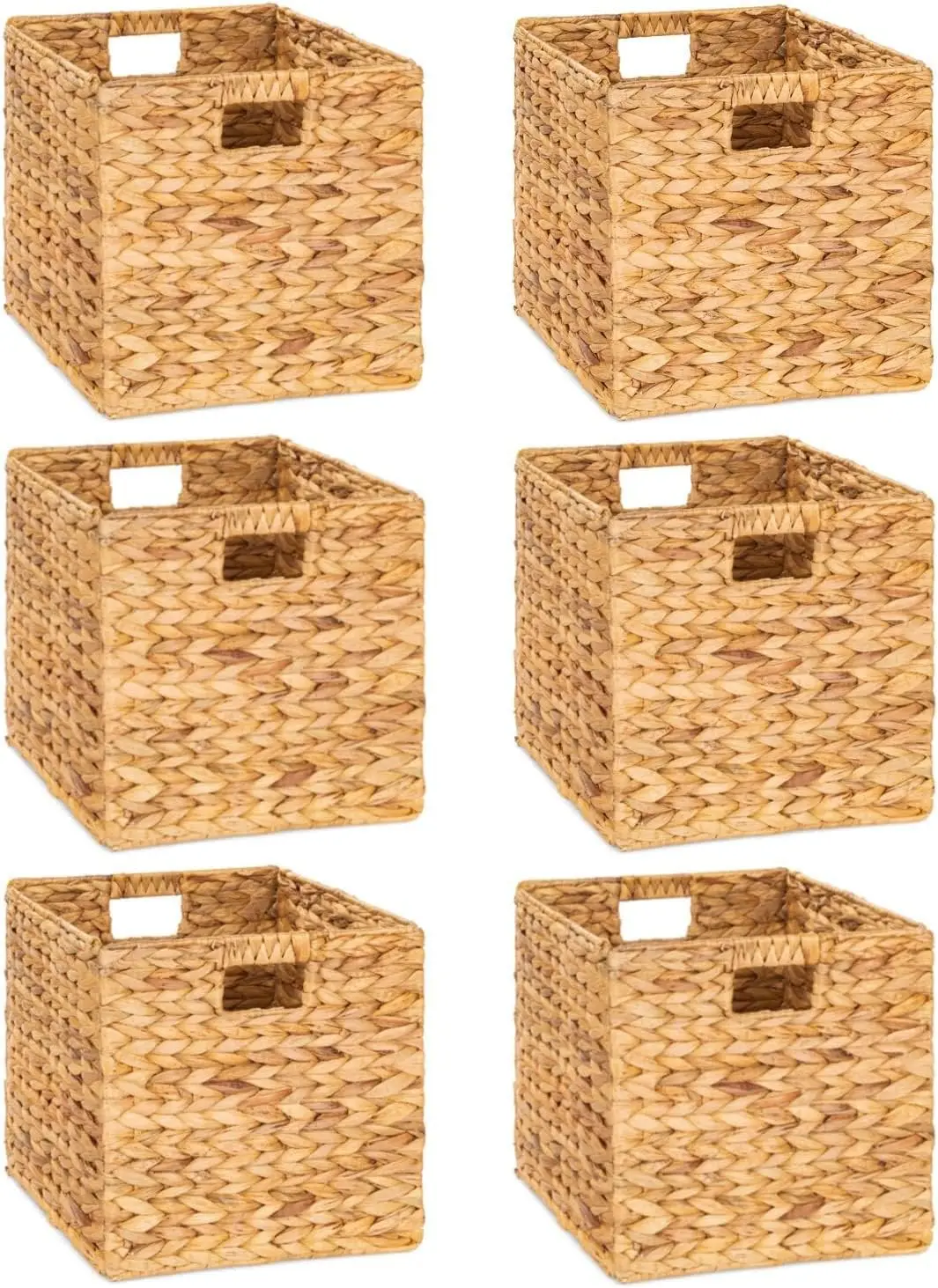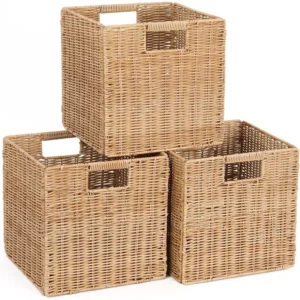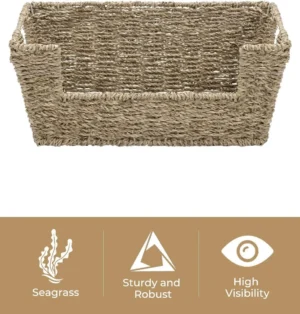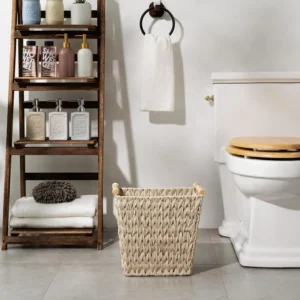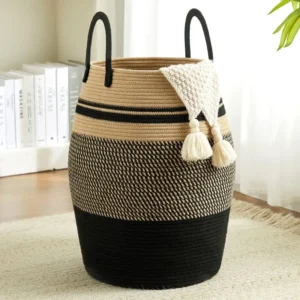The Essence of Wicker in Minimalist Design
Minimalism in interior design is characterized by clean lines, intentional use of space, and a deliberate reduction of clutter. It’s about creating calm environments where every item serves a purpose and contributes to the overall aesthetic. Within this philosophy of “less is more,” natural materials like wicker can play a surprisingly significant role.
Wicker brings an organic warmth and texture to minimalist spaces that might otherwise feel cold or sterile. The natural fibers introduce subtle visual interest without overwhelming the senses, creating balance in spaces defined by simplicity. This natural material adds depth and character while still honoring minimalist principles of intentionality and restraint.
Many people mistakenly associate wicker exclusively with traditional, rustic, or bohemian interiors. However, this versatile material has evolved significantly in contemporary design. Today’s wicker baskets feature cleaner lines and more refined weaves that align perfectly with minimalist aesthetics. High-end interior designers increasingly incorporate wicker elements as counterpoints to sleek, modern furnishings.
The beauty of wicker in minimalist design lies in this tension between natural imperfection and deliberate simplicity. When selected thoughtfully, wicker pieces don’t detract from minimalist principles—they enhance them by adding just enough texture and visual interest without creating visual chaos.
This material’s evolution in modern design showcases how traditional craft can be reimagined for contemporary sensibilities. From mid-century modern pieces with wicker elements to today’s Scandinavian-inspired designs, wicker has proven its adaptability across design movements that value simplicity and functionality.
Why Wicker Complements Minimalist Aesthetics
Wicker possesses several inherent qualities that make it particularly suited to minimalist environments, creating harmony rather than discord within these carefully curated spaces.
Key benefits of incorporating wicker into minimalist design include:
Natural texture without overwhelming complexity: Wicker provides visual texture that adds depth to minimalist spaces without the busy patterns or overwhelming details that would contradict minimalist principles.
Organic warmth to balance minimalism’s potential starkness: The natural fibers introduce a sense of warmth and comfort that softens the sometimes cold or austere feeling of strictly minimalist rooms.
Sustainability aligns with mindful consumption: The natural materials used in quality wicker pieces align with the minimalist focus on intentional, sustainable purchasing decisions.
Versatile neutral tones complement minimalist color palettes: From light blonde to deeper honey tones, wicker’s natural palette integrates seamlessly with the restrained color schemes typical of minimalist interiors.
Design psychology reveals that humans instinctively respond positively to natural textures in our environments. In minimalist spaces where visual stimuli are deliberately reduced, the subtle complexity of wicker provides just enough sensory engagement without overwhelming the senses. This creates spaces that feel both calming and interesting—a difficult balance to achieve.
The elegant laundry solutions that wicker provides demonstrate how functional objects can also be aesthetically pleasing. This integration of beauty and utility stands at the heart of thoughtful minimalist design, where each item must earn its place through both form and function.
Interior designers specializing in minimalism often note that the most successful spaces aren’t devoid of texture—they simply limit texture to carefully selected materials. Wicker can serve as this featured textural element, creating focal points that draw the eye without overwhelming the space. The result is a room that feels intentional and harmonious rather than stark and impersonal.
When incorporated thoughtfully, wicker creates what designers call “quiet interest”—visual engagement that doesn’t demand attention but rewards it when given. This subtle complexity is precisely what elevates minimalist spaces from simply empty to beautifully essential.
Selecting Minimalist-Friendly Wicker: Form and Structure
Not all wicker pieces are created equal when it comes to minimalist compatibility. The form and structure of wicker items play crucial roles in determining whether they’ll enhance or detract from your minimalist space.
When selecting wicker pieces for minimalist interiors, prioritize these characteristics:
Clean, simple silhouettes: Look for pieces with straightforward shapes and minimal ornamentation. Avoid pieces with elaborate details, ruffles, or decorative flourishes.
Geometric forms and straight lines: Wicker items with geometric shapes and clean lines integrate more seamlessly with minimalist aesthetics than curvy, ornate designs.
Modern and Scandinavian-inspired designs: Contemporary wicker pieces influenced by Scandinavian design principles typically feature the restraint and functionality that minimalism demands.
The concept of visual weight is particularly important when selecting wicker for minimalist spaces. Visual weight refers to how heavy or substantial an object appears, regardless of its actual physical weight. In minimalism, balance is key—pieces should feel proportional to their surroundings without overwhelming the space.

When evaluating wicker items, consider their silhouette when viewed from a distance. Would the outline appear clean and intentional? Or does it have irregular protrusions and details that create visual complexity? Rectangle wicker baskets often work particularly well in minimalist settings because their clean, geometric forms echo the intentional lines found throughout minimalist design.
Compare these examples:
- Minimalist-compatible: A simple wicker chair with a clean frame, straight lines, and minimal detailing
- Less compatible: A wicker peacock chair with elaborate fan-shaped back and ornate detailing
The difference lies not just in the amount of visual detail, but in the clarity of form. Minimalist design values pieces where the eye can easily comprehend the overall shape without being distracted by excessive details.
Remember that in minimalism, the principle of “less is more” applies not just to quantity but to design complexity. A single well-chosen wicker piece with a clean, architectural form makes a stronger minimalist statement than multiple items with busy designs.
The Perfect Finish: Color and Weave Considerations
Beyond form and structure, the specific weave patterns and color finishes of wicker pieces significantly impact how well they integrate into minimalist spaces. These surface qualities determine whether a piece reads as refined and intentional or busy and distracting.
For minimalist environments, certain weave patterns work better than others:
- Tight, uniform weaves create a more refined, contemporary appearance suitable for minimalist aesthetics
- Simple, consistent patterns maintain visual calm compared to complex, varied weaves
- Straight, parallel weaving often appears more modern than intricate diagonal or circular patterns
Color selection is equally important when incorporating wicker into minimalist spaces. Consider these options:
- Natural finishes like blonde, honey, and light gray wicker maintain the material’s inherent appeal while blending with minimalist palettes
- Painted options such as matte black or white wicker can create stronger contemporary statements for modern minimalist spaces
- Consistent toning across different wicker pieces helps maintain cohesion throughout a space
Black wicker baskets offer particularly striking options for contemporary minimalist spaces, providing contrast against lighter backgrounds while maintaining clean lines and simple forms. Their monochromatic appearance often reads as more intentional and less rustic than natural-toned alternatives.
When selecting wicker finishes, consider your existing color scheme. In spaces with warm neutrals, honey-toned wicker creates harmony, while cooler minimalist palettes often pair better with gray-toned or white wicker. The goal is integration rather than contrast—the wicker should feel like an intentional extension of your design language.
Texture consistency across different wicker pieces also contributes to a cohesive minimalist look. Mixing dramatically different weave styles can create visual discord, while choosing pieces with related weaving techniques maintains the sense of intentional curation essential to minimalist spaces.
The stylish rattan storage options available today demonstrate how refined weaving techniques can elevate simple storage pieces into design features that enhance rather than detract from minimalist aesthetics. When evaluating wicker finishes, look beyond immediate appeal to consider how the piece will integrate with your overall design direction.
Essential Wicker Pieces for Minimalist Living Areas
The living area offers numerous opportunities to incorporate wicker thoughtfully while maintaining minimalist principles. Focus on selecting key pieces that serve both functional and aesthetic purposes.
Wicker Seating Options
When considering wicker seating for minimalist living spaces, prioritize these characteristics:
- Accent chairs with architectural frames that feature clean lines and minimal ornamentation
- Dining chairs with simple silhouettes that pair harmoniously with minimalist tables
- Stools and ottomans that provide flexible functionality with straightforward forms
The best minimalist wicker chairs feature frames with clear, definable shapes and weaving that appears almost architectural in its precision. Look for pieces where the structure itself becomes the design statement, rather than added decorative elements.
Tables and Surfaces
For tables incorporating wicker elements, consider these minimalist-friendly options:
- Coffee tables with glass tops supported by simple wicker bases, creating visual lightness
- Side tables with clear geometric forms and uniform weaving patterns
- Console tables with clean lines and minimal structural elements
Scale consideration is crucial when selecting larger wicker pieces for minimalist spaces. In smaller rooms, choose pieces with open weaving or glass elements to maintain visual spaciousness. Larger spaces can accommodate more substantial wicker pieces, though their forms should remain clean and intentional.
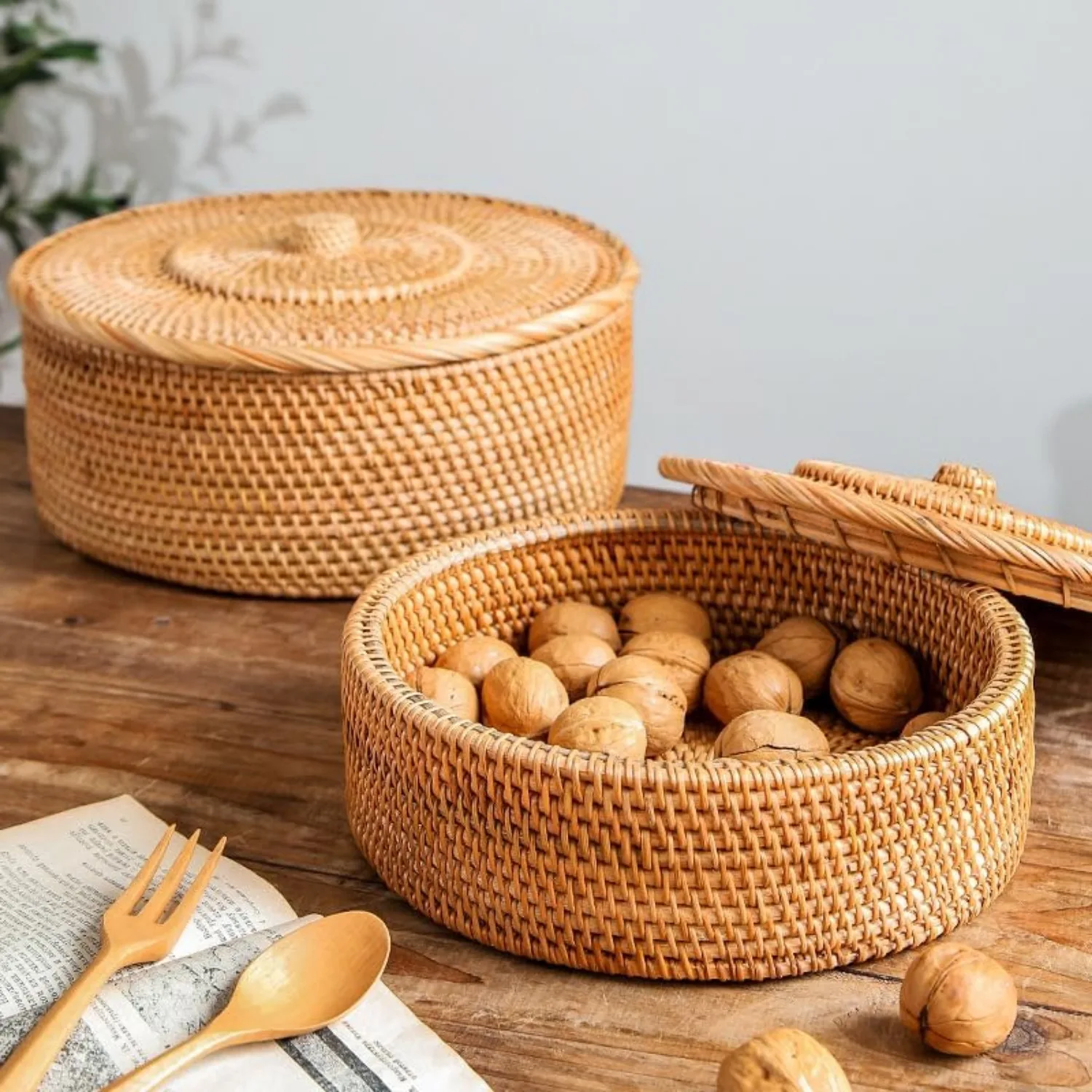
Wicker storage baskets serve as excellent functional accents in living spaces, providing necessary organization while contributing to the overall aesthetic. When selecting these pieces, maintain consistency in form and finish to create a cohesive look that reads as intentional rather than haphazard.
For material pairings, wicker works particularly well with:
- Glass elements that create contrast between natural texture and sleek transparency
- Minimal metal frames that provide structural definition
- Simple upholstery in solid neutral tones that allow the wicker’s texture to stand out
Each wicker piece should earn its place in your minimalist space through both functionality and aesthetic contribution. Rather than selecting items simply because they’re made of wicker, choose pieces that would enhance your space regardless of material, with the wicker element adding beneficial texture to your minimalist scheme.
Wicker Storage Solutions for Minimalist Organization
Storage represents one of the most practical and aesthetically pleasing applications of wicker in minimalist design. Quality wicker storage pieces naturally align with minimalist organization principles by concealing visual clutter while adding subtle texture.
The best wicker storage solutions for minimalist spaces include:
- Baskets and bins with simple shapes for everyday organization needs, from media storage to children’s toys
- Storage ottomans that serve dual purposes as seating and hidden storage
- Magazine holders and desktop organizers with clean lines to maintain order in work spaces
- Laundry hampers with straight sides and minimal details for unobtrusive functionality

The strategic use of wicker storage baskets with lids proves particularly valuable in minimalist settings. Covered storage maintains visual calm by concealing contents while presenting a clean exterior form. This approach transforms necessary items from potential clutter into design elements that contribute positively to your space.
For maintaining minimalist principles, consider these wicker storage strategies:
- Choose storage pieces with consistent heights when grouping multiple baskets together
- Select uniform styles rather than mixing different weaving patterns
- Use baskets sized appropriately for their contents to avoid overcrowding
- Create visual breathing space between storage elements rather than crowding them together
The effortless laundry organization that wicker baskets provide demonstrates how functional items can be elevated through thoughtful material selection. In minimalist homes, these pieces do double duty—solving organizational challenges while enhancing the aesthetic quality of the space.
When selecting storage dimensions, consider both current and future needs. Properly scaled storage prevents the need for multiple smaller containers that could create visual fragmentation. A few well-chosen, appropriately sized pieces maintain cleaner visual lines than numerous mismatched containers.
The beauty of wicker storage in minimalist spaces lies in this perfect marriage of form and function. Each basket or bin serves a concrete organizational purpose while simultaneously contributing texture and warmth to spaces that might otherwise feel stark or impersonal.
Illuminating Minimalist Spaces with Wicker Lighting
Lighting presents another opportunity to incorporate wicker’s natural texture into minimalist environments. When selected thoughtfully, wicker lighting fixtures create focal points that add character without overwhelming the space.
For minimalist-compatible wicker lighting, consider these options:
- Pendant lights with geometric forms such as spheres, cylinders, or cones
- Table and floor lamps with simple bases and clean-lined shades
- Wall sconces with minimal projection from the wall surface
The interplay between light and wicker creates compelling visual effects in minimalist spaces. Light filtering through wicker weaves casts subtle shadow patterns that add dimension to walls and surfaces without introducing busy patterns or colors. This dynamic quality brings movement and interest to minimalist rooms while maintaining their essential simplicity.
When selecting wicker lighting for minimalist spaces, consider scale carefully in relation to ceiling height and room dimensions. Oversized pendants can serve as artistic focal points in rooms with ample vertical space, while more compact fixtures maintain appropriate proportions in spaces with lower ceilings.
The best wicker baskets for laundry organization demonstrate principles of form and function that apply equally to lighting selection. Just as these storage solutions balance practicality with aesthetics, wicker lighting should provide adequate illumination while enhancing your space’s design language.
For maximum compatibility with minimalist design, look for lighting with these characteristics:
- Simple suspension systems without decorative chains or cords
- Clean connection points where different materials meet
- Uniform weaving patterns without decorative variations
- Natural finishes that complement your overall color palette
When positioned thoughtfully, wicker lighting creates what designers call “pools of interest”—areas where the eye naturally rests when scanning a room. In minimalist spaces where visual stimulation is deliberately limited, these subtle focal points become even more important for creating rooms that feel designed rather than simply empty.
Decorative Wicker Accents: The Art of Subtle Enhancement
Decorative accents represent the final layer in minimalist design—the carefully chosen details that add personality without creating clutter. With wicker accents, restraint is particularly important to maintain minimalist integrity.
For minimalist-appropriate decorative wicker, consider these options:
- Mirrors with simple wicker frames that add texture without ornate detailing
- Wall art using woven panels with geometric patterns or subtle tonal variations
- Trays for organized surface displays that corral small items into cohesive groupings
- Simple wicker planters that showcase plants while adding natural texture
The principle of meaningful minimalism—choosing fewer, better pieces—is especially relevant when selecting decorative accents. Each item should serve a purpose, whether functional or purely aesthetic, and contribute positively to the overall atmosphere of your space.
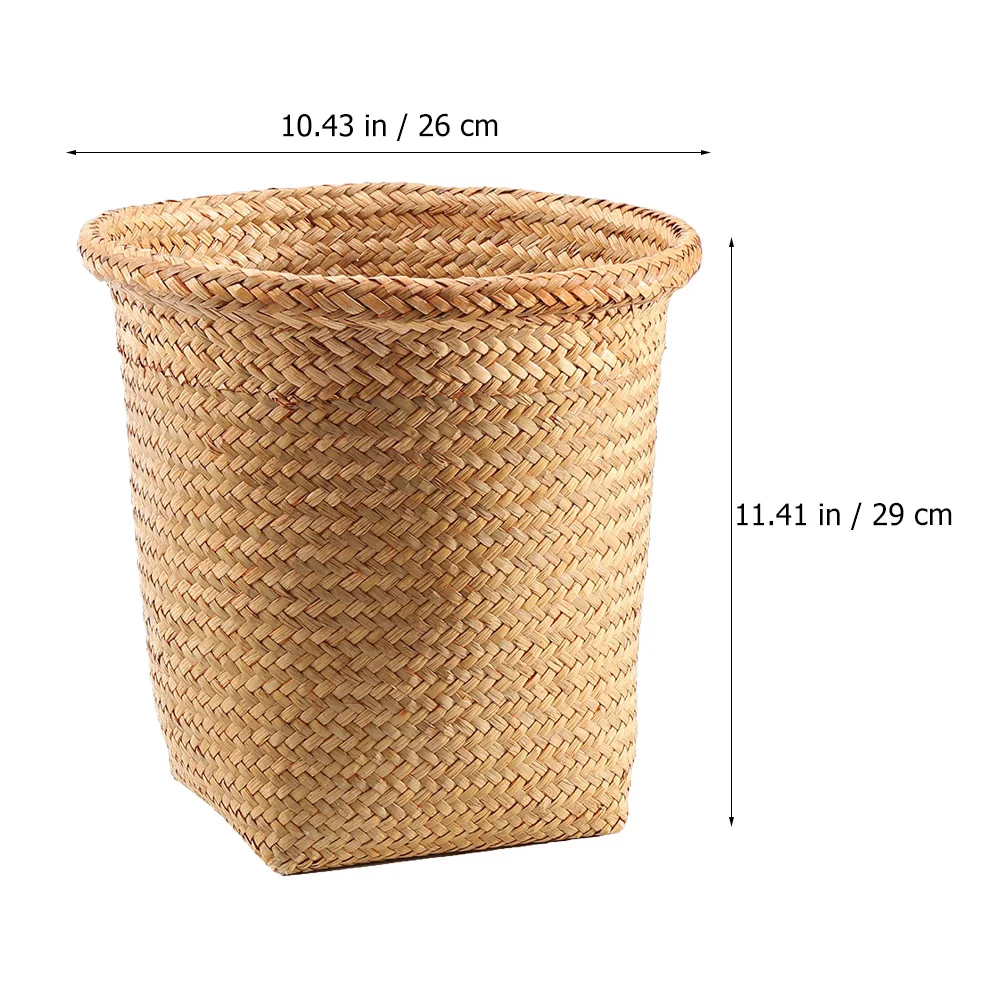
Even utilitarian items like wicker waste baskets can become decorative elements when thoughtfully selected. These functional accents add textural interest to spaces like bathrooms and offices while maintaining clean lines and simple forms that complement minimalist design.
Strategic placement enhances the impact of decorative wicker pieces. Consider these placement principles:
- Position wicker accents where they create textural contrast with surrounding materials
- Allow adequate visual space around decorative items rather than clustering them together
- Place wicker pieces where natural light can highlight their textural qualities
- Use wicker accents to draw attention to architectural features worth emphasizing
The storage ideas that work for larger wicker pieces apply equally to decorative accents—thoughtful positioning and appropriate scale matter just as much as the items themselves. A small, well-placed wicker accent often makes a stronger design statement than multiple competing pieces.
Remember that in minimalist design, negative space—the empty areas around objects—is just as important as the objects themselves. Allow your wicker accents room to “breathe” by maintaining generous space around them, letting their natural texture stand out against simpler backgrounds.
Material Harmony: Pairing Wicker with Other Minimalist Elements
Creating cohesive minimalist spaces involves thoughtful material combinations that complement wicker’s natural characteristics. The right pairings enhance wicker’s textural qualities while maintaining overall design harmony.
For balanced material combinations with wicker, consider these pairings:
- Smooth surfaces like glass, polished concrete, and metal create textural contrast that highlights wicker’s organic qualities
- Complementary textiles such as linen, cotton, and wool in neutral tones add softness without competing textures
- Wood tones that either closely match or clearly contrast with your wicker pieces maintain intentional material relationships
The principle of texture contrast plays an important role in successful minimalist design. While minimalism values simplicity, completely smooth environments can feel sterile and unwelcoming. Wicker introduces natural texture that creates sensory interest without overwhelming the space, especially when balanced against sleeker surfaces.
Color harmony between wicker and other materials helps maintain cohesion throughout minimalist spaces. Consider these color relationships:
- Natural wicker tones paired with whites and light grays create bright, airy minimalist spaces
- Honey-colored wicker combines beautifully with warm neutrals and natural wood tones
- Black or charcoal wicker provides striking contrast in predominantly white minimalist environments
The DIY laundry organization approaches that work with wicker baskets demonstrate how this material can be customized to harmonize with existing elements. Similarly, you can select wicker with specific finishes and tones that complement your space’s unique material palette.
Creating visual interest through thoughtful material mixing remains essential in minimalist spaces. Rather than relying on decorative objects, minimalism often achieves richness through the interplay of carefully selected materials. Wicker’s natural variation provides subtle complexity that pairs well with more uniform surfaces.
The principles of matching baskets in home decor apply broadly to material harmony—consistency in key visual elements creates cohesion, while controlled variation prevents monotony. With wicker, this might mean selecting pieces with related but not identical weaves, or choosing items that share color tones while featuring different textures.
Room-by-Room Guide to Incorporating Wicker
Each room in your home presents unique opportunities for incorporating wicker within a minimalist framework. Let’s explore specific applications for different living spaces:
Living Room
In minimalist living rooms, wicker can create serene gathering spaces when incorporated thoughtfully:
- Position a clean-lined wicker accent chair as a textural counterpoint to a simple sofa
- Use wicker coffee tables or side tables with glass elements to maintain visual openness
- Incorporate storage baskets to organize media, throws, or other essentials while adding texture
- Consider a simple wicker pendant light as a focal point above seating areas
Bedroom
For tranquil bedroom retreats, wicker adds warmth without busy patterns:
- Select a minimalist wicker headboard with straight lines and uniform weaving
- Use underbed wicker storage boxes to maintain clean floor space
- Choose bedside tables with simple wicker elements for subtle texture
- Add wicker laundry hampers with clean forms and minimal detailing
Home Office
Productive minimalist workspaces benefit from organized wicker elements:
- Incorporate desktop organizers with simple wicker construction to corral supplies
- Choose a desk with subtle wicker detailing on drawer fronts or legs
- Add file baskets with straight sides and consistent weaving patterns
- Use wicker waste baskets that complement other office materials
Entryway
First impressions benefit from functional wicker pieces:
- Install wall-mounted wicker storage for mail and essentials
- Position a simple wicker bench for seating when removing shoes
- Add lidded storage baskets below benches to contain seasonal items
- Include a clean-lined wicker mirror to add dimension while maintaining simplicity
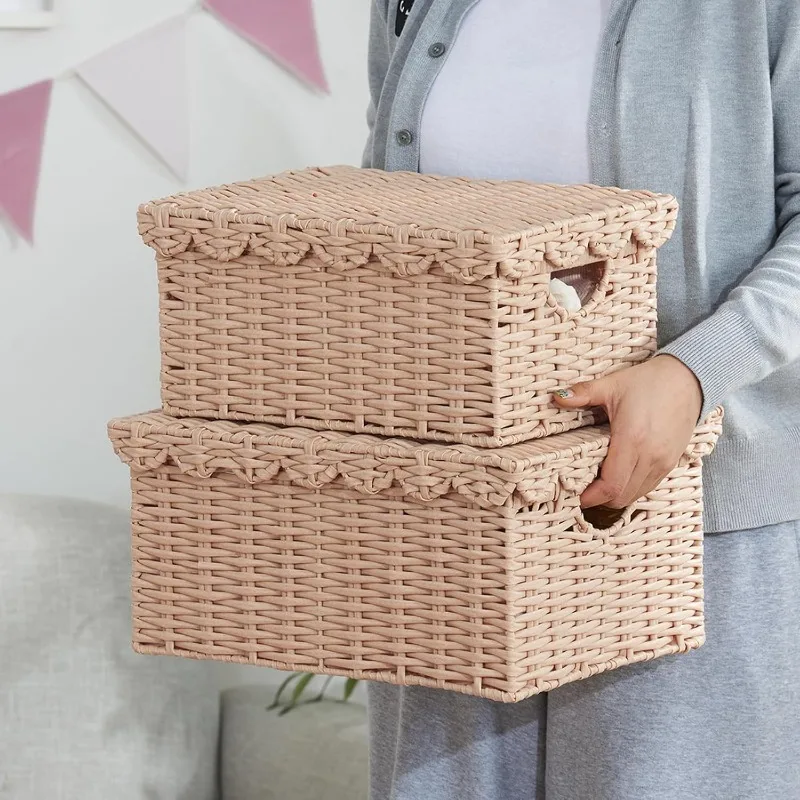
Bathroom
Create spa-like organization with water-resistant wicker options:
- Select covered wicker hampers with minimal detailing
- Use small wicker baskets to organize toiletries on shelves or countertops
- Choose wicker waste baskets with clean forms and sealed finishes
- Incorporate simple wicker shelving for towels and necessities
Black Wicker Baskets, Rattan Storage Baskets, Tall Wicker Baskets, Wicker Shelf Baskets, Woven Storage Baskets
5-Tier Distressed Black Wood Frame Storage Tower with Removable Wicker Baskets for Home Organization$715.80 Select options This product has multiple variants. The options may be chosen on the product pageWicker Laundry Baskets, Woven Laundry Baskets, Woven Storage Baskets
$392.02 Select options This product has multiple variants. The options may be chosen on the product pageRattan Shelf Baskets, Rattan Storage Baskets, Small Wicker Baskets, Square Wicker Baskets
Square Plastic Wicker Storage Baskets Set of 3 with Collapsible Design for Cube Storage Organization$185.47 Select options This product has multiple variants. The options may be chosen on the product pageWicker Baskets with Handles, Wicker Storage Baskets, Woven Storage Baskets
$137.92 Select options This product has multiple variants. The options may be chosen on the product page- $119.02 Select options This product has multiple variants. The options may be chosen on the product page
Large Wicker Laundry Baskets, Tall Wicker Baskets, Woven Laundry Hampers, Woven Storage Baskets
$130.54 Select options This product has multiple variants. The options may be chosen on the product page
Dining Area
Minimalist entertaining spaces benefit from selected wicker elements:
- Choose dining chairs with simple wicker backs and clean frames
- Add a wicker bread basket with straightforward form and consistent weaving
- Use placemats with subtle wicker texture for table setting interest
- Include a simple wicker pendant light above the dining table
The versatile rattan storage baskets offered by Tidy Treasure work well across these different spaces, providing functional storage while maintaining minimalist aesthetics. Their consistent quality and clean design language create cohesion throughout the home.
Room-specific considerations should always include scale and proportion relative to the space. In smaller rooms, choose fewer, more impactful wicker pieces rather than multiple smaller items that could create visual clutter. Larger spaces can accommodate more substantial wicker elements while still maintaining minimalist principles.
The decorative yet functional wicker pieces that work well for laundry organization can often translate effectively to other rooms. This cross-functional approach aligns with minimalist values by reducing the need for numerous specialized items throughout the home.
Avoiding Common Pitfalls: Maintaining Minimalist Integrity
When incorporating wicker into minimalist spaces, several common mistakes can undermine your design goals. Being aware of these pitfalls helps you maintain minimalist integrity while successfully integrating wicker elements.
Common Mistakes and Solutions
Overcrowding with too many wicker pieces
– DO: Select one or two standout wicker items as focal points
– DON’T: Fill the space with multiple competing wicker elements
– SOLUTION: Edit ruthlessly, keeping only the most impactful and functional pieces
Mixing incompatible wicker styles
– DO: Maintain consistency in weave patterns and color tones
– DON’T: Combine dramatically different wicker types within the same space
– SOLUTION: Establish a cohesive “wicker language” throughout your home
Choosing overly complex or decorative pieces
– DO: Select wicker with clean lines and simple forms
– DON’T: Incorporate pieces with ornate details or busy patterns
– SOLUTION: Evaluate each piece against minimalist principles before purchasing
Improper scaling for the space
– DO: Choose pieces proportioned appropriately for your room dimensions
– DON’T: Select oversized wicker that dominates smaller spaces
– SOLUTION: Consider the visual weight of wicker items in relation to surrounding elements
Understanding whether wicker baskets are appropriate for specific functional needs helps you make decisions that support both practical requirements and aesthetic goals. This evaluation process applies to all wicker elements in minimalist design—each piece should serve a clear purpose while contributing positively to the visual environment.
Balancing interest and simplicity represents the central challenge of incorporating wicker in minimalist spaces. The goal isn’t to eliminate texture entirely but to control it intentionally. Wicker should add just enough visual interest to prevent sterility without creating visual chaos.
Using negative space intentionally around wicker pieces enhances their impact while maintaining minimalist principles. Allow adequate breathing room around textural elements rather than crowding them together—this spatial generosity is what distinguishes thoughtful minimalism from simply sparse design.
Caring for Wicker in Minimalist Homes
Maintaining wicker pieces properly preserves both their appearance and structural integrity, aligning with minimalist values of quality and longevity. Simple care routines ensure your wicker investments continue enhancing your space for years to come.
Basic Care Guidelines
For natural wicker finishes:
– Dust regularly with a soft brush attachment on your vacuum
– Wipe occasionally with a slightly damp cloth (not soaking wet)
– Avoid direct sunlight that could fade or dry out natural fibers
– Apply food-grade mineral oil annually to prevent drying and cracking
For painted or sealed wicker:
– Dust regularly with a microfiber cloth
– Clean with a slightly damp cloth and mild soap as needed
– Touch up any chips in paint promptly to prevent further damage
– Apply furniture wax occasionally to maintain finish
Seasonal considerations:
– During dry winter months, maintain adequate humidity to prevent wicker from becoming brittle
– During humid summer months, ensure good air circulation around wicker pieces
The practical storage solutions offered by Tidy Treasure are designed for easy maintenance, with finishes that resist everyday wear. This practicality aligns with minimalist values of choosing quality items that remain beautiful with minimal effort.
For long-term care, the proper basket maintenance approaches that preserve wicker’s minimal aesthetic include preventive measures rather than reactive repairs. Regular light maintenance prevents the need for more intensive restoration later, supporting minimalism’s sustainability focus.
When wicker pieces do require repair, address issues promptly with simple techniques that maintain clean aesthetics. For minimalist environments, repairs should be invisible—preserving the piece’s simple lines and uniform appearance rather than creating visible patches or fixes.
These maintenance practices align with minimalist principles of intentional ownership—caring properly for fewer, better things rather than constantly replacing lower-quality items. Quality wicker pieces reward this care by developing character while maintaining their essential forms, becoming longstanding elements of your minimalist home.
Is Wicker Right for Your Minimalist Space? Decision Guide
While wicker can enhance many minimalist interiors, it’s not automatically suitable for every space. This evaluation framework helps you determine whether wicker aligns with your specific minimalist vision:
Assessment Questions
Compatibility with existing elements:
– Do your current furniture pieces feature clean lines and simple forms?
– Is your color palette primarily neutral with minimal pattern?
– Does your space already incorporate natural materials?
– Would wicker’s texture complement or compete with existing textural elements?
Space considerations:
– Do you have adequate visual space for additional textural elements?
– Would wicker pieces maintain appropriate scale relative to your room dimensions?
– Is your lighting conducive to highlighting wicker’s textural qualities?
– Do you need additional warmth or softening in primarily hard-surfaced spaces?
Personal preferences:
– Does your minimalist approach value natural materials and handcrafted elements?
– Are you drawn to subtle texture rather than completely smooth surfaces?
– Do you prefer warm versus cool minimalist environments?
– Is your minimalist style more Scandinavian, Japanese, or contemporary?
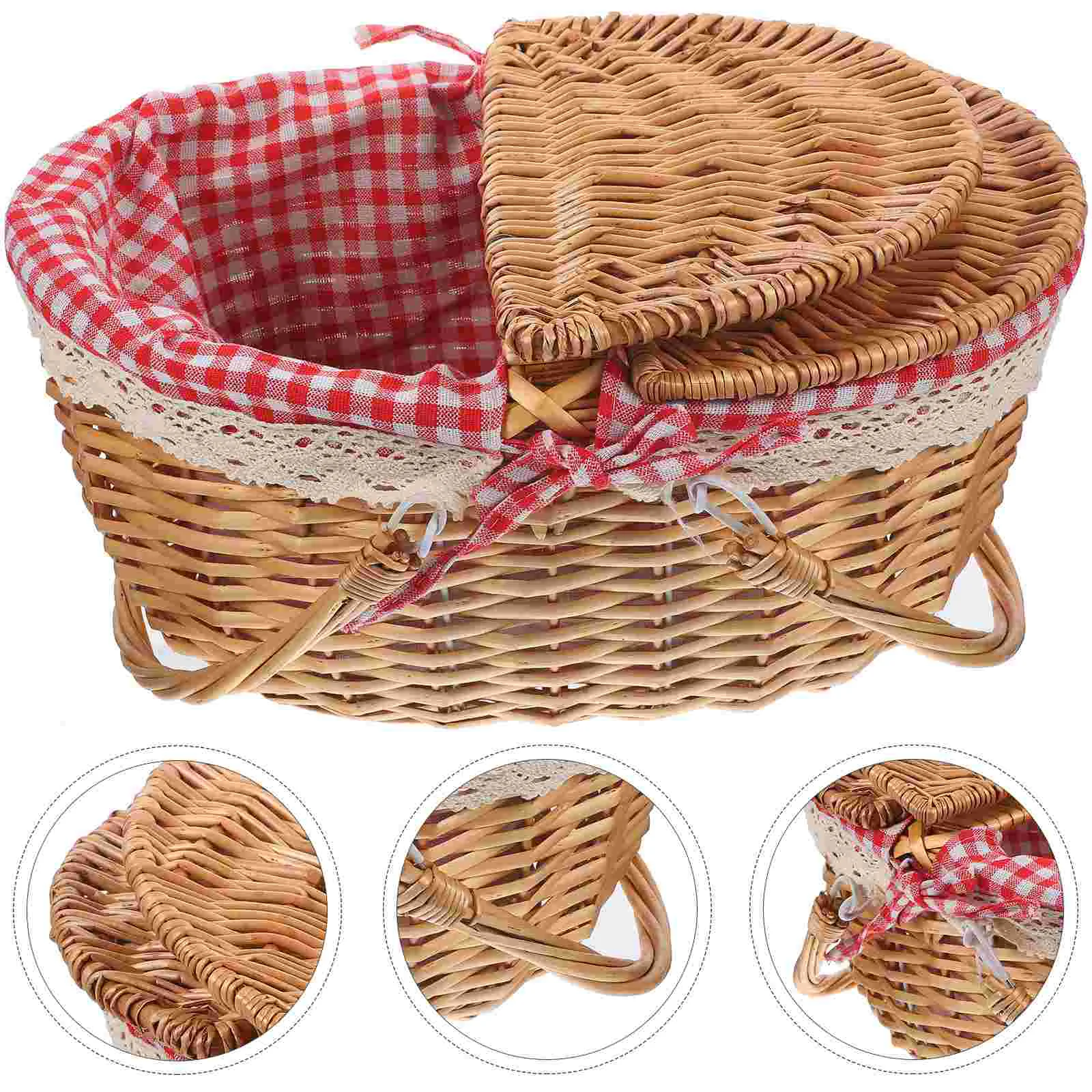
Functional requirements:
– Do you need storage solutions that conceal contents?
– Would furniture with both functional and aesthetic qualities benefit your space?
– Are there areas where additional texture would enhance the sensory experience?
– Do you require durable materials for high-use items?
The organizational insights gained from wicker storage applications can help determine whether this material meets your minimalist needs. Consider how wicker’s functional properties align with your specific organizational challenges.
For spaces where wicker might not be ideal—extremely modern environments with primarily metal and glass elements, for example—consider these alternatives that offer similar benefits:
- Matte ceramic pieces for subtle texture without natural fibers
- Smooth wooden elements with minimal grain for warmth without visible texture
- Textured fabrics in neutral tones for softness without visual complexity
Remember that minimalism encompasses diverse sub-styles, from warm Scandinavian approaches that embrace natural materials to cooler contemporary interpretations that favor sleeker surfaces. Your specific version of minimalism will determine how readily wicker integrates into your design vision.
Finding Quality Minimalist Wicker: What to Look For
The investment perspective of minimalist purchasing—choosing fewer, better items—makes quality assessment particularly important when selecting wicker pieces. These criteria help identify wicker that will maintain its minimalist appeal over time:
Quality Indicators
Construction details:
– Even, consistent weaving without gaps or irregularities
– Tight connections where different wicker elements meet
– Solid inner frames that provide structural stability
– Reinforced stress points in furniture pieces
Material considerations:
– Natural rattan or water hyacinth for durability in furniture
– Sustainable harvesting practices for eco-conscious minimalism
– Weather-resistant synthetic options for high-moisture environments
– Even coloration throughout natural materials
Craftsmanship indicators:
– Precision in repeated patterns
– Clean, finished edges without fraying
– Symmetrical forms and balanced proportions
– Attention to detail in joints and connection points
Finish quality:
– Smooth, even application of paints or sealants
– Non-tacky surface texture
– UV-resistant finishes for pieces in sunlight
– Water-resistant treatments for bathroom or kitchen items
The top-rated wicker baskets that maintain minimalist principles typically demonstrate these quality markers. Their structural integrity and refined aesthetics justify their place in carefully curated minimalist spaces.
When evaluating wicker quality, distinguish between purely aesthetic appeal and true durability. Quality wicker should maintain its minimalist appeal over time, aging gracefully rather than quickly becoming misshapen or damaged. This longevity aligns with minimalist values of intentional purchasing and reduced consumption.
Consider long-term material aging when selecting wicker pieces. Natural wicker typically darkens slightly over time, developing a rich patina that actually enhances its character. For minimalist spaces, this aging process should be uniform and subtle rather than irregular or dramatic.
Embracing Wicker in Your Minimalist Journey
As we’ve explored throughout this guide, the thoughtful incorporation of wicker into minimalist spaces creates environments that feel both curated and livable. By balancing texture, form, and function, wicker enhances minimalist interiors without compromising their essential simplicity.
The key principles for successfully integrating wicker into minimalist design include:
- Intentionality in selection and placement, choosing pieces that serve clear purposes while enhancing aesthetic quality
- Balance of texture against smoother elements, creating visual interest without overwhelming the senses
- Consistency in quality, finish, and form across different wicker pieces
- Restraint in quantity, favoring fewer standout pieces over numerous smaller items
Within these principles lies room for personal expression. Your unique minimalist journey might incorporate wicker differently than others—perhaps featuring a statement wicker chair in one home, while another uses subtle wicker storage throughout. This personalization makes minimalist spaces feel authentic rather than formulaic.
The transformative potential of thoughtfully chosen wicker elements extends beyond aesthetics to how we experience our homes. Natural materials connect us to the wider world, adding warmth and character to minimalist spaces that might otherwise feel disconnected or sterile.
The timeless appeal of wicker in simplified spaces stems from this perfect balance of natural imperfection against deliberate restraint. As trends come and go, the pairing of wicker’s organic texture with minimalism’s intentional simplicity remains relevant and compelling.
By applying the guidance in this comprehensive guide, you can create minimalist spaces that feel both serene and inviting—environments that calm the mind while engaging the senses through thoughtful material selection. The result is a home that honors minimalist principles while reflecting your unique aesthetic vision and practical needs.

